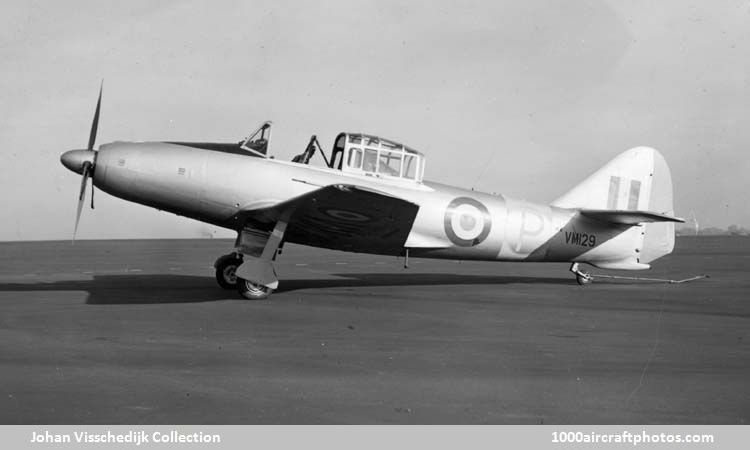06/30/2011. Remarks by Johan Visschedijk: "Designed by S. D. Davies, the Athena T.Mk.1 was a three-seat advanced trainer with turboprop engine built to Air Ministry Specification T.7/45. Intended to replace the Percival Prentice as the standard RAF basic trainer, it was an all-metal, low wing monoplane which used the same airfoil section as the Hawker Tempest in order to reproduce fighter-style handling qualities.
Work began in March 1947 but after the first fuselage and wing structure had gone to Farnborough for strength tests, changing requirements of RAF Training Command and non-availability of turbine engines led to the replacement of the original specification by T.14/47 stipulating a change of power plant to the 1,280 hp Rolls-Royce Merlin 35 twelve-cylinder liquid-cooled V-engine, large stocks of which were held in store. Considerable redesign resulted in the Athena T.Mk.2 on which the mainplane had been moved forward 27 inches to compensate for the greater weight of the piston engine.
Nevertheless work continued at Manchester on the installation of gas turbines in three airframes. These small diameter engines gave a much improved view over the nose but required a large diameter jet pipe ejecting through the fuselage side aft of the starboard wing root on the 1,010 hp Armstrong Siddeley Mamba 1 powered Athena T.Mk.1, serials VM125 and VM132, and under the fuselage on the 1,400 hp Rolls-Royce Dart engined Athena T.Mk.1A, serial VM129. VM125 was first flown at Woodford on June 12, 1948 by J. H. Orrell, VM129 first flew September 17, 1949, while VM132 first flew December 12, 1949.
Four Merlin powered Athena T.Mk.2 prototypes were produced, serials VW890 to VW893. VW890 (first flown on August 1, 1948) and VW892 were delivered to Boscombe Down for performance tests, subsequently VW890 underwent tropical trials as did VW891 which had been used for tail modifications. VW893 went to the Empire Test Pilots' School at Farnborough, and this was followed by evaluation of two production aircraft, serials VR566 and VR567, at the Central Flying Establishment in October 1949.
The center section of the Athena T.Mk.2 housed an inward retracting Lockheed landing gear, main fuel tanks, 0.303 in (7.7 mm) Browning gun, 300 rounds of ammunition and a G.45B camera gun. It was also made immensely strong to minimize damage in the event of a wheels-up landing and was equipped with attachment points for bomb racks or 45 gallon drop tanks as well as access doors to the internal engineering. Although provision was made for folding wings they were not built as the naval requirement was withdrawn before the first Athena flew. Engine cooling was by beard-type Morris radiator, and a target-towing point was situated under the tail.
Whereas the first and third prototype Athena T.Mk.2s and all the turboprop machines had triangular fins and small unbalanced rudders, the second prototype Athena T.Mk.2, serial VW891, was fitted with a balanced rudder of greater area hinged to a larger fin. This rudder was a feature of all production aircraft but with fin cut back to give the tail unit a tall angular appearance. The canopy was also shortened by moving the radio forward and eliminating the third seat.
The Athena T.Mk.2 replaced the Harvard for armament training at the RAF Flying College at Manby, for which purpose provision was made for two 60 lb (27 kg) rocket projectiles under each wing. Production was abandoned after the construction of fifteen aircraft, serials VR566 to VR580, but VR569 (c/n 1519) was given the civil registration G-ALWA on December 19, 1949 for a demonstration tour of India, its CofA No. 10797 was issued February 2, 1950. It returned to Croydon on May 13, reverted to the Ministry of Supply as VR569 on July 11, and was demonstrated at the Farnborough SBAC Show in September 1950 by Avro test pilot J. Nelson."
